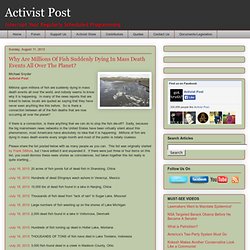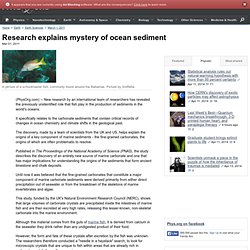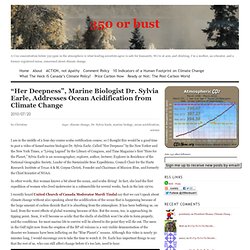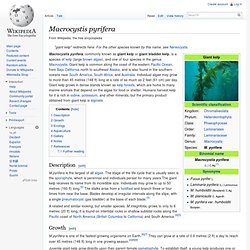

WikiSky. Academic Earth. Academic Earth. Why Are Millions Of Fish Suddenly Dying In Mass Death Events All Over The Planet? Michael SnyderActivist Post Millions upon millions of fish are suddenly dying in mass death events all over the world, and nobody seems to know why it is happening.

In many of the news reports that are linked to below, locals are quoted as saying that they have never seen anything like this before. So is there a connection between all of the fish deaths that are now occurring all over the planet? If there is a connection, is there anything that we can do to stop the fish die-off? Sadly, because the big mainstream news networks in the United States have been virtually silent about this phenomenon, most Americans have absolutely no idea that it is happening. Please share the list posted below with as many people as you can.
List of cetaceans. This is a list of cetaceans.

The order Cetacea includes whales, dolphins, and porpoises. It has around 90 living species, divided into the suborders Odontoceti (the toothed whales, including dolphins and porpoises) and Mysticeti (the baleen whales). In addition, numerous species of extinct cetaceans exist, but they are not listed here. This list contains only the known, extant cetacean species including several recent discoveries (the baiji is also included, though it is believed to have gone extinct in 2006). Suborder Mysticeti: baleen whales[edit] Shark Trust. NikitaShielRolle. Seafood Choices Alliance - Who We Are. Advancing the market for sustainable seafood Seafood Choices Alliance is an international program that provides leadership and creates opportunities for change across the seafood industry and ocean conservation community.

Founded in the United States in 2001, Seafood Choices helps the seafood industry— from fishermen and fish farmers to processors, distributors, retailers, restaurants, and food service providers —to make the seafood marketplace environmentally, economically and socially sustainable. We're about synergies and identifying creative solutions to long-held challenges. By building relationships and stimulating dialogue, Seafood Choices is encouraging and challenging all sectors of the seafood industry along the road toward sustainability.
Mission. Research explains mystery of ocean sediment. (PhysOrg.com) -- New research by an international team of researchers has revealed the previously unidentified role that fish play in the production of sediments in the world's oceans.

It specifically relates to the carbonate sediments that contain critical records of changes in ocean chemistry and climate shifts in the geological past. Reference: Ocean Survival is Our Survival. Ocean Survival is Our Survival The oceans are dying . This is not a new thing, it happend several times in the world's history. The causes have differend but one recurring trigger has often been rapid climate change, either warming or cooling. We now experience warming due to CO2 emissions . According to some experts Global Warming should be called Ocean Warming, as 80% of the heat ends up in our oceans . “Her Deepness”, Marine Biologist Dr. Sylvia Earle, Addresses Ocean Acidification from Climate Change « 350 or bust.
I am in the middle of a four-day course scuba certification course, so I thought this would be a good time to post a video of famed marine biologist Dr.

Sylvia Earle. Called “Her Deepness” by the New Yorker and the New York Times, a “Living Legend” by the Library of Congress, and Time Magazine’s first “Hero for the Planet,” Sylvia Earle is an oceanographer, explorer, author, lecturer, Explorer in Residence of the National Geographic Society, Leader of the Sustainable Seas Expeditions, Council Chair for the Harte Research Institute at Texas A & M, Corpus Christi, Founder and Chairman of Mission Blue, and formerly the Chief Scientist of NOAA. CETO - wave energy for electricity production and desalination of seawater. 101216_In-ocean Buoyant Actuator Testing.pdf (application/pdf Object) Australian climate variability & change - Time series graphs.
Skip to main content Home About Contacts NSW Weather & Warnings Warnings Summary Forecasts Sydney Forecast NSW Forecast Area Map Observations Sydney Observations All NSW Observations Rainfall & River Conditions VIC Weather & Warnings.

Australian Antarctic Magazine. Earth & Environmental Science - Oceanography. Limnology and Oceanography. Lenfest Ocean Program. Oceanography Home. Southern Ocean ‘warming faster’ Ocean acidification. NOAA provides evidence for upwelling of corrosive "acidified" water onto the Continental Shelf.

In the figure above, note the vertical sections of (A) temperature, (B) aragonite saturation, (C) pH, (D) DIC, and (E) pCO2 on transect line 5 off Pt. St. George, California. The potential density surfaces are superimposed on the temperature section. Ocean Acidification. Acid oceans may harm fish young. "High carbon dioxide concentrations can cause death and organ damage in very young fish.

" Image: lisegagne/iStockphoto Ocean acidification – caused by climate change – looks likely to damage crucial fish stocks. Two studies just published in Nature Climate Change reveal that high carbon dioxide concentrations can cause death and organ damage in very young fish. The work challenges the belief that fish, unlike organisms with shells or exoskeletons made of calcium carbonate, will be safe as marine CO2 levels rise. Ocean Acidification Network. Marine and Atmospheric Research - Our Research. Feely.pdf (application/pdf Object) Australian Ocean Data Centre » Welcome to the AODC Web Page.
Marine biology. Only 29 percent of the world surface is land.

Marine Species Identification Portal. Macrocystis pyrifera. Macrocystis pyrifera, commonly known as giant kelp or giant bladder kelp, is a species of kelp (large brown algae), and one of four species in the genus Macrocystis.

Giant kelp is common along the coast of the eastern Pacific Ocean, from Baja California north to southeast Alaska, and is also found in the southern oceans near South America, South Africa, and Australia. Individual algae may grow to more than 45 metres (148 ft) long at a rate of as much as 2 feet (61 cm) per day. Giant kelp grows in dense stands known as kelp forests, which are home to many marine animals that depend on the algae for food or shelter. Fishwise - GenusSpecies Search. Climatic Change, Volume 77, Numbers 3-4.